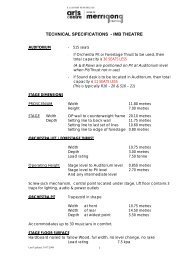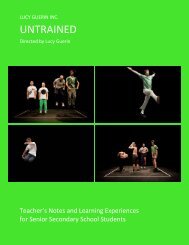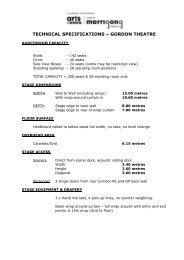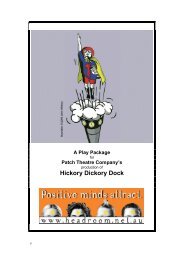Rainbow’s End
Download - Merrigong Theatre Company
Download - Merrigong Theatre Company
- No tags were found...
You also want an ePaper? Increase the reach of your titles
YUMPU automatically turns print PDFs into web optimized ePapers that Google loves.
Most Aborigines live a long way from the dust stirred up by the Northern Territory intervention. But the bleak reality of<br />
their expectations for health, education and employment is not so distant from that of the most remote communities.<br />
The invisibility of local Aborigines, hidden by regional prosperity and an enduring social apartheid only now beginning<br />
to fracture, is remarked upon by community leaders white and black. Shepparton City chief executive Bob Laing, a<br />
Kiwi import who is still surprised at the chasm between Maori and Aboriginal circumstance, questions how the<br />
broader community has for so long been "so accepting about such social disadvantage".<br />
Though it is home to Victoria's largest Koori community, "there are people in Shepparton who would not have had<br />
contact with an Aboriginal person", says local indigenous leader (and Les' younger brother) Paul Briggs. A one-day<br />
spot audit of all the major supermarkets, chain stores and banks in town a couple of years ago found not one<br />
Aborigine among 221 front-of-house workers. "That diminishes us, and diminishes our relationship."<br />
These days local Aboriginal reality is as often as not obscured by public preoccupation with the gross hardships of<br />
life in remote communities in the red centre and the far north, where the news crews, politicians and football teams fly<br />
when they want to engage with, as Paul Briggs puts it, "real blackfellas". In fact, as confirmed by new Australian<br />
National University modelling, 43% — and growing — of Aboriginal people live in places such as Shepparton: rural<br />
and regional towns. By comparison, 15% live in places such as Mutitjulu, and another 8% in far-flung outstations.<br />
Measuring distance between Aboriginal reality in the Northern Territory and in northern Victoria is a slippery<br />
business. It can seem as far apart as the map decrees when you stand on the earth floor of the tiny concrete house<br />
maintained as a museum piece in the grounds of the Rumbalara Aboriginal Co-operative — first-generation, stateowned<br />
Aboriginal housing circa 1958. The old house is disconcertingly similar to those occupied by many Northern<br />
Territory Aborigines.<br />
Such accommodation has long since been left behind in Shepparton, and yet distance vanishes when you compare<br />
the graphs plotting the journey from birth to death of Victorian Aborigines against those who live in the Territory.<br />
Bearing in mind that the NT has an overall Aboriginal population more than twice that of Victoria, the percentage of<br />
low-birthweight babies born to Aboriginal mothers in Victoria is not only much higher than non-Aboriginal numbers, it<br />
is also comparable to the NT rate: 12.75% compared to 13.3% in 2003. By 2006, in Victoria, it was 13.4%, almost<br />
double that of non-Aboriginal Victorian mothers.<br />
New state figures show the gap between the life expectancy of Aboriginal and non-Aboriginal Victorians has grown.<br />
They predict Aboriginal children born this decade (to 2006) will have 19 fewer years than other Victorians — boys<br />
living to 60 compared with 79; girls to 65 compared with 84. Aboriginal men in the NT have even grimmer prospects<br />
(57.6 years). But it's noteworthy that the gaps between indigenous and non-indigenous life expectancy are much<br />
larger in Victoria than the most recent NT figures (2001), where the difference was 13.2 years for males, and 11.3 for<br />
females.<br />
On the question of child welfare and safety — the core concern of the NT intervention — latest Victorian figures show<br />
the number of Aboriginal children found to be in need of protection, following an investigation, is more than 10 times<br />
that of the non-Aboriginal population, despite a significant drop in the past few years. Felicia Dean, who as chief<br />
executive of Rumbalara Aboriginal Co-operative oversees a range of welfare programs, believes the safety of<br />
Victorian Aboriginal children is as fragile as that of children in the north, primarily due to neglect. She is also<br />
concerned that the slowness of an overstressed system is putting children at even greater risk.<br />
Continue to paint by numbers across a range of benchmarks defining quality of life, and the emerging picture is<br />
frequently as dark for Victoria as for remote communities. Kindergarten participation rates are low and declining.<br />
Staggeringly high rates of mental illness afflict Aboriginal men and women. Alcohol-related hospital admissions for<br />
Aboriginal men are 10 times the rate of non-Aboriginal admissions, for drugs the difference is fivefold. Loss of<br />
Aboriginal students at year 10 in Victoria is, with NSW, the worst in the nation.<br />
In Shepparton, a Melbourne University study published last year found the average Koori student was leaving school<br />
before the end of year 8, and by year 12 less than one-quarter were still at school. At the primary level many<br />
struggle, Achievement Improvement Monitor testing showing they typically lag six months behind in numeracy and<br />
literacy.<br />
Prospects beyond school are dismal. While north-east Victoria has the lowest unemployment rate in the country, at<br />
2.3%, the Shepparton Aboriginal jobless rate is almost 10 times that. An extrapolation of a local survey and case files<br />
kept by Rumbalara puts the figure at closer to 35%.<br />
11













